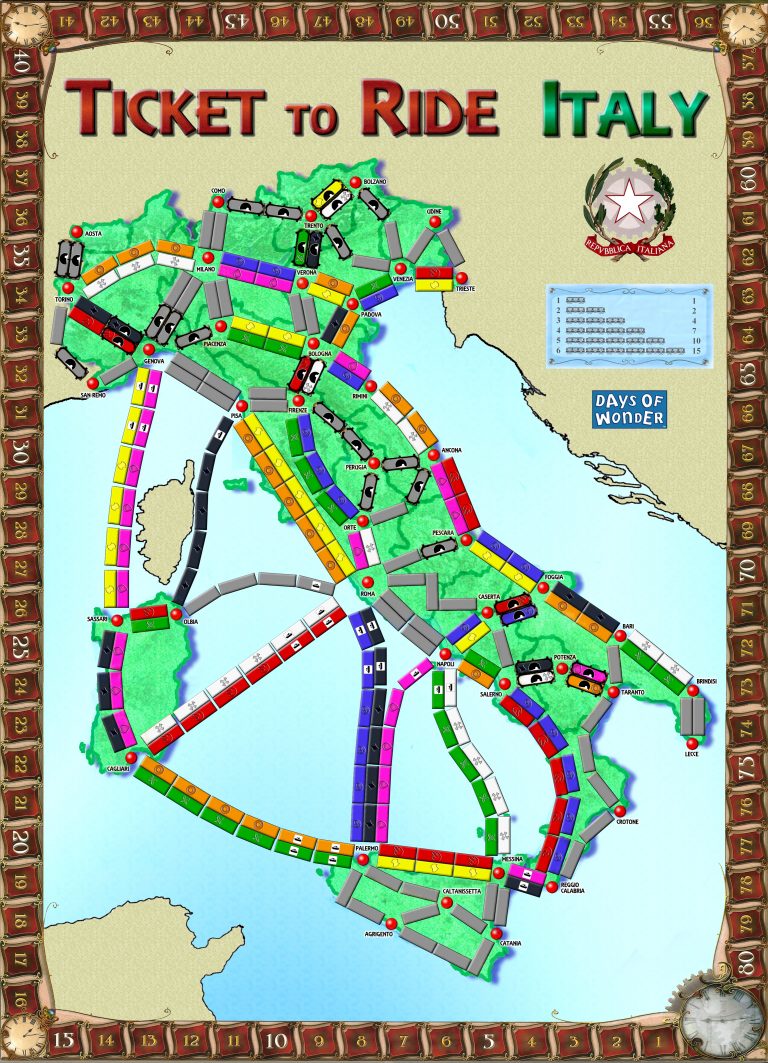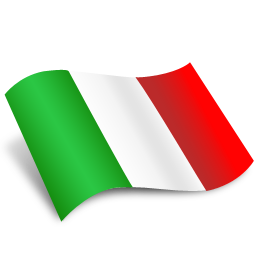
Table of Contents
Introduction
Ticket to Ride Italy is a customized unofficial version of the board game Ticket to Ride (also known as Zug um Zug in the German version) published by Days of Wonder. You must own a box of the original game (either the USA or Europe version) to be able to play this version. This map is similar as much as possible to the real rail (and ferries) Italian network, even if some modifications and simplifications have been necessary for graphics reasons. You will also find the tickets to use with the map.
The game is for 2 to 5 players and can be played in two different ways:
- Basic Rules (based on “Ticket to Ride USA”)
- Advanced Rules (based on “Ticket to Ride Europe”)
For additional informations please see the original rule booklet coming with the original game.
Basic Rules
Based on “Ticket to Ride USA” version.
Setup. Each player receives 42 train cars (instead of 45 as in the original game), 4 train cards and 3 destination cards (there’s no difference between long and short routes in this case). Each player must keep at least 2 destination cards.
Game Turn. On his turn, a player must perform one (and only one) of the following four actions:
- Draw 2 train cards (or 1 face-up locomotive).
- Claim a route, by playing a valid set of train cards (in two or three player games, only one of the double-routes can be used). Simply ignore the “Tunnel” and “Ferry” symbols on the routes.
- Draw 3 new destination tickets and keep at least one.
Game End. When any one player’s stock of colored plastic trains gets down to two trains or less at the end of his turn, each player, including that player, gets one final turn.
Scoring. At the end of game, the players count the points made by claiming routes (this could be done also during the game). Moreover the value of completed tickets is added and the value of incomplete tickets is deducted. Finally, give the 10 point bonus for the to the player(s) who have the longest continuous path on the board.
Advanced Rules
Based on “Ticket to Ride Europe” version.
Setup. Each player receives 42 train cars (instead of 45 as in the original game), 3 train stations, 4 train cards and 4 destination cards (1 long route and 3 short routes). Each player must keep at least 2 destination cards.
Game Turn. On his turn, a player must perform one (and only one) of the following four actions:
- Draw 2 train cards (or 1 face-up locomotive).
- Claim a route, by playing a valid set of train cards (in two or three player games, only one of the double-routes can be used. To claim a tunnel route, a player first lays down the number of cards required by the length of the route, then he turns face-up as many cards as the number of tunnel symbols on the route (instead of turning exactly 3 cards like in the original game). For each card revealed whose color matches the color of the cards played to claim the tunnel, an additional card of the same color (or a locomotive) must now be played from his hand. To claim a ferry route, a player must play a locomotive card for each ferry symbol on the route, and the usual set of cards of the proper color for the remaining spaces of that ferry route.
- Draw 3 destination tickets and keep at least one.
- Build a station in any city that does not yet have one. To build the first, second or third station, the player plays a combination of one, two or three train cards of the same color. A station allows its owner to use one, and only one, of the routes belonging to another player, into (or out of) that city to help him connect the cities on his destination tickets.
Game End. When any one player’s stock of colored plastic trains gets down to two trains or less at the end of his turn, each player, including that player, gets one final turn.
Scoring. At the end of game, the players count the points made by claiming routes (this could be done also during the game). Moreover the value of completed tickets is added and the value of incomplete tickets is deducted. Add to the score of each player four points for each unplayed station they still have in reserve. Finally, give the 10 point bonus for the to the player(s) who have the longest continuous path on the board.
Credits
“Ticket to Ride Italy” was created by Marco Chiesi. Special thanks to Alan R. Moon (author of the original game), David Millard (for his UK map) and Umberto Di Caprio (for the enhancements to the map).
